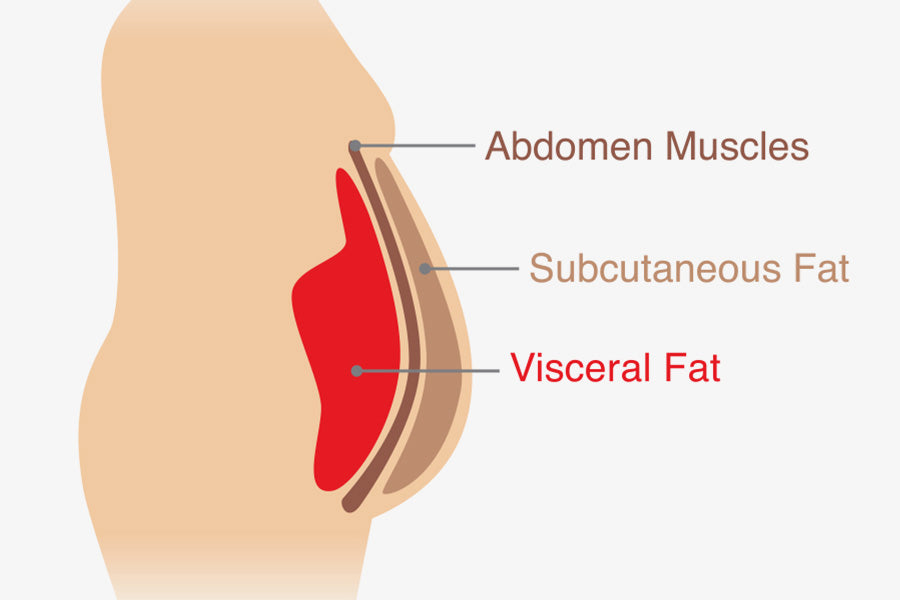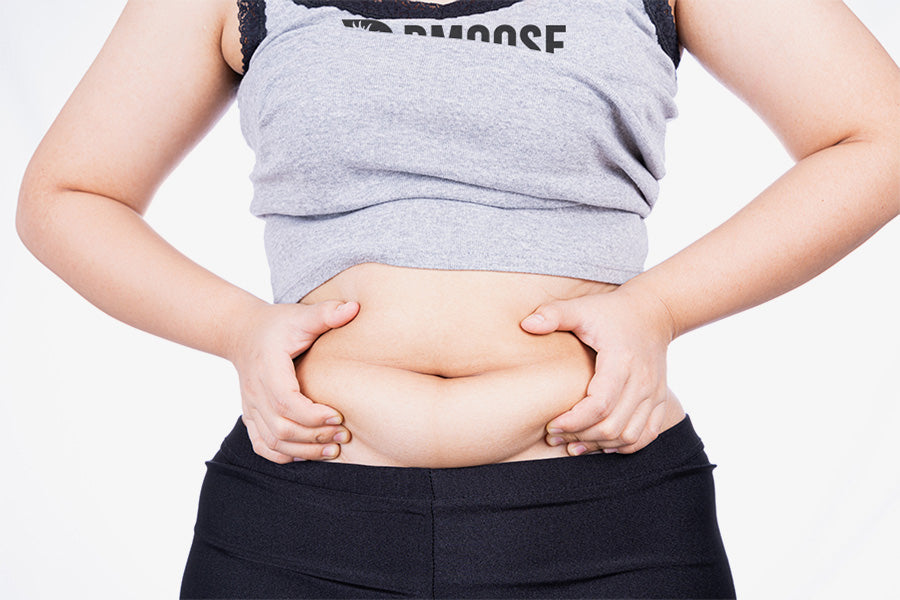Lower belly fat is one of the most frustrating and challenging areas to reduce fat from, especially for women. Often called stubborn belly fat, it can be particularly challenging to shift regardless of what diet or exercise routine you try. Knowing what causes lower belly fat and what tips to follow can help you reach your goal of a flatter stomach.
The most common cause of lower belly fat is a combination of poor diet, lack of physical activity, stress, hormonal imbalances, and genetics. A poor diet that consists mostly of processed foods rich in trans fats and sugars can lead to weight gain over time that accumulates around the abdominal area.
Not getting enough physical activity can also contribute to weight gain, as it reduces the energy used to support metabolism and fat burning.
Additionally, stress is known to increase cortisol levels in the body, which can cause fat deposits around your abdomen. Hormonal imbalances due to menopause or menstrual cycle changes can also contribute to lower belly weight gain.
Finally, genetics play a role in stubborn belly fat females; if you have family members battling this issue, you may have inherited their predisposition for abdominal fat storage.
Let's scroll down to find out what visceral fat is, the role of clean eating, and how exercises can help shed stubborn lower belly fat.
What is Visceral Fat?

Visceral fat is an accumulation of fat around the internal organs such as the liver, intestines, and pancreas. It is stored deep in the abdominal cavity and can be particularly stubborn to shift. Compared to subcutaneous fat (situated just beneath your skin), visceral fat has a higher rate of metabolism.
It, therefore, produces more hormones which can hurt your overall health. High amounts of visceral fat are linked with an increased risk for diabetes, cardiovascular disorders, and some types of cancer.
Role of Clean Eating in Reducing Lower Belly Fat
Eating clean food is essential for any successful weight loss plan, but it should be especially emphasized even more when trying to get rid of stubborn lower belly fat. Clean eating means avoiding processed and packaged foods high in sugar and trans fats and food with added preservatives.
Instead, eating a diet rich in whole grains, vegetables, lean proteins, fresh fruits, healthy fats, and complex carbohydrates will help you achieve your desired results in the safest way possible.
What to Eat
The first tip is to incorporate fiber-rich foods, such as oats, quinoa, vegetables, and fruits, into your diet to help improve digestion and reduce water retention. Moreover, to build muscle and burn fat, you must consume lean proteins from fish, chicken, and eggs. These foods keep you full for a longer duration.
According to a study, consuming about one portion of legumes daily, such as beans, chickpeas, lentils, or peas, boost feelings of fullness, promote healthier weight management, and even aid in losing excess pounds.
Furthermore, fresh fruits and vegetables provide essential vitamins, minerals, and antioxidants that can also aid in the reduction of stubborn belly fat. Numerous clinical studies have demonstrated that when individuals consume more fruit each day, they are far less likely to experience weight gain.
Including healthy fats such as avocado, nuts, and seeds for essential fatty acids that can help reduce inflammation. Besides, you must drink enough water to stay hydrated and flush out toxins.
In addition, whole grains like oats, quinoa, or brown rice are also a great addition to any diet plan when trying to lose weight since they’re packed with fiber-rich complex carbohydrates, which help regulate blood sugar levels. Certain observational studies hint that the intake of whole grains may lower the risk of weight gain.
What Not to Eat
The key is avoiding refined sugars plus processed foods, as they can add unnecessary calories that are hard to burn. It is also crucial to avoid saturated fats found in red meat and processed meats. According to a review of data published in the International Journal of Obesity, individuals who consume more than 5 ounces of red meat daily are 27% more likely to become overweight compared to those eating lean proteins and 33% more likely to accumulate abdominal fat that can lead towards cardiovascular diseases.
Moreover, you must also cut down on carbohydrates like pasta, rice, and bread. If you do prefer them, opt for whole wheat versions instead. Last but not least, it’s time to say goodbye to trans fats, often found in fried and packaged foods such as chips or biscuits.
How to Reduce Lower Belly Fat With Exercise
Physical activity is essential to reducing stubborn lower belly fat, as it helps reduce overall body fat percentage. Regular exercise helps increase your metabolism and burn off excess calories. Aim for 30 minutes of moderate-intensity exercise 5 days a week or 20 minutes of high-intensity interval training 3 times per week.
Cardiovascular activities like running, swimming, and cycling can help you lose weight in the abdominal area. Strength training exercises such as lunges, planks, and squats can also help build muscle mass and burn off fat more quickly.
Including both aerobic exercises and resistance training is crucial in developing strong muscles and burning off stubborn lower belly fat. However, it’s important to remember that diet still plays an essential role in weight loss. A balanced diet will help you reduce belly fat more quickly and effectively.
Studies show that high-intensity interval training (HIIT) is also an effective way to reduce lower belly fat. HIIT involves short, intense periods of exercise followed by rest or recovery. This training helps burn more calories in less time and increases the body’s ability to burn fat more efficiently.
Try to make time for regular physical activity each day or week and combine it with a nutritious diet for the best results. With dedication and consistency over time, you can achieve your goals of reducing stubborn lower belly fat.
Exercises for Reducing Lower Belly Fat
Getting regular exercise is integral to reducing stubborn lower belly fat. Aim for 30 minutes of moderate-intensity exercise for five days, including walking, running, cycling, and swimming. High-intensity interval training (HIIT) is also an effective way to burn stubborn lower belly fat.
Strength Training

These exercises help build muscle mass, increase metabolism, and burn excess calories. Incorporating these into your routine can help reduce stubborn lower belly fat. Additionally, try to ensure you get enough rest and recovery between workouts. This will help to ensure that your body can rebuild the muscles lost during exercise. Some of the strength training exercises include:
- Squats
- Lunges
- Planks
- Deadlifts
- Pushups
- Pull-Ups/Chin-Ups
Cardio Sessions

Cardiovascular activities such as running, swimming, and cycling can help reduce stubborn lower belly fat. Incorporating these into your routine will help increase your metabolism and burn excess calories. Regular cardio sessions at a moderate intensity for 30 minutes or more can help reduce overall body fat percentage over time. Some of the cardio exercises include:
- Running
- Swimming
- Cycling
- Jumping Rope
- Elliptical Training
Compound Exercises

Compound exercises are a great way to burn off stubborn lower belly fat. These involve multiple muscle groups and will help you build strength and increase your metabolic rate. Aim for 20 minutes of these exercises 5 days a week which can effectively reduce overall body fat percentage and reduce stubborn lower belly fat.
- Burpees
- Mountain Climbers
- Squat Jumps
- Bear Crawls
- Skipping Rope
Related Article: What are Compound Exercises? All You Need to Stay Fit for Life
FAQs
1. Can you lose some belly fat in one week?
Yes, losing some belly fat in one week with the right diet and exercise regimen is possible. Eating a healthy, balanced diet and engaging in regular physical activity are essential for reducing belly fat. However, it’s important to note that results will vary from person to person, so be patient and consistent with your efforts.
2. What exercises help reduce lower belly fat?
Combining strength training and aerobic activity can help lower belly fat. High-intensity interval training (HIIT) and compound exercises such as squats, lunges, deadlifts, and planks are all great options for targeting stubborn lower belly fat. Light cardio, such as walking or jogging, can support your efforts.
3. What should I avoid eating to reduce belly fat?
Avoiding processed and sugary foods is critical for reducing stubborn lower belly fat. Eating whole foods such as lean proteins, fruits, vegetables, and healthy fats is essential for losing weight over time. Limiting the intake of refined carbohydrates like white bread, pasta, and other grain-based products can also be beneficial in reducing belly fat.
4. Can you flatten your stomach in a week?
Flattening your stomach in one week may not be possible, but with the proper diet and exercise habits, it is possible to reduce unhealthy levels of belly fat. Eating a healthy, balanced diet and engaging in regular physical activity are essential for achieving your goals. Be patient with your progress, and you will be sure to get the results you’re after!
Conclusion
Reducing stubborn lower belly fat can be challenging, but it is possible with changes in diet, lifestyle, and exercise habits. Eating clean foods rich in nutrients, including lean proteins, fresh fruits and vegetables, whole grains, low-fat dairy products, and healthy fats, reduces visceral fat.
Additionally, exercising regularly and incorporating high-intensity interval training into your workout routine can help you lose weight more effectively and reduce abdominal fat. Combining these strategies allows you to reach a healthier, more toned body.
It may take time and dedication, but reducing stubborn lower belly fat with the proper diet, lifestyle, and exercise habits is possible. With the tips mentioned above, you can finally start saying goodbye to stubborn lower belly fat!
Now that you have all the tips needed to get rid of lower belly fat, what are you waiting for? Start making healthy changes today and see positive changes in your body in no time!
Reading List
Article Sources
- Aller, Erik E. J. G., et al. “Starches, Sugars, and Obesity.” Nutrients, vol. 3, no. 3, Mar. 2011, pp. 341–69. PubMed Central, https://doi.org/10.3390/nu3030341
- Bendsen, N. T., et al. “Effect of Trans Fatty Acid Intake on Abdominal and Liver Fat Deposition and Blood Lipids: A Randomized Trial in Overweight Postmenopausal Women.” Nutrition & Diabetes, vol. 1, no. 1, Jan. 2011, p. e4. PubMed Central, https://doi.org/10.1038/nutd.2010.4
- Li, Siying S., et al. “Dietary Pulses, Satiety and Food Intake: A Systematic Review and Meta-Analysis of Acute Feeding Trials.” Obesity (Silver Spring, Md.), vol. 22, no. 8, Aug. 2014, pp. 1773–80. PubMed, https://doi.org/10.1002/oby.20782
- Liu, Ann G., et al. “A Healthy Approach to Dietary Fats: Understanding the Science and Taking Action to Reduce Consumer Confusion.” Nutrition Journal, vol. 16, Aug. 2017, p. 53. PubMed Central, https://doi.org/10.1186/s12937-017-0271-4
- Maillard, Florie, et al. “Effect of High-Intensity Interval Training on Total, Abdominal and Visceral Fat Mass: A Meta-Analysis.” Sports Medicine (Auckland, N.Z.), vol. 48, no. 2, Feb. 2018, pp. 269–88. PubMed, https://doi.org/10.1007/s40279-017-0807-y
- Maki, Kevin C., et al. “The Relationship between Whole Grain Intake and Body Weight: Results of Meta-Analyses of Observational Studies and Randomized Controlled Trials.” Nutrients, vol. 11, no. 6, May 2019, p. 1245. PubMed Central, https://doi.org/10.3390/nu11061245
- “NIH Study Finds Heavily Processed Foods Cause Overeating and Weight Gain.” National Institutes of Health (NIH), 16 May 2019, https://www.nih.gov/news-events/news-releases/nih-study-finds-heavily-processed-foods-cause-overeating-weight-gain
- P., Nirmala Prasadi V., and Iris J. Joye. “Dietary Fibre from Whole Grains and Their Benefits on Metabolic Health.” Nutrients, vol. 12, no. 10, Oct. 2020, p. 3045. PubMed Central, https://doi.org/10.3390/nu12103045
- Sharma, Satya P., et al. “Paradoxical Effects of Fruit on Obesity.” Nutrients, vol. 8, no. 10, Oct. 2016, p. 633. PubMed Central, https://doi.org/10.3390/nu8100633











